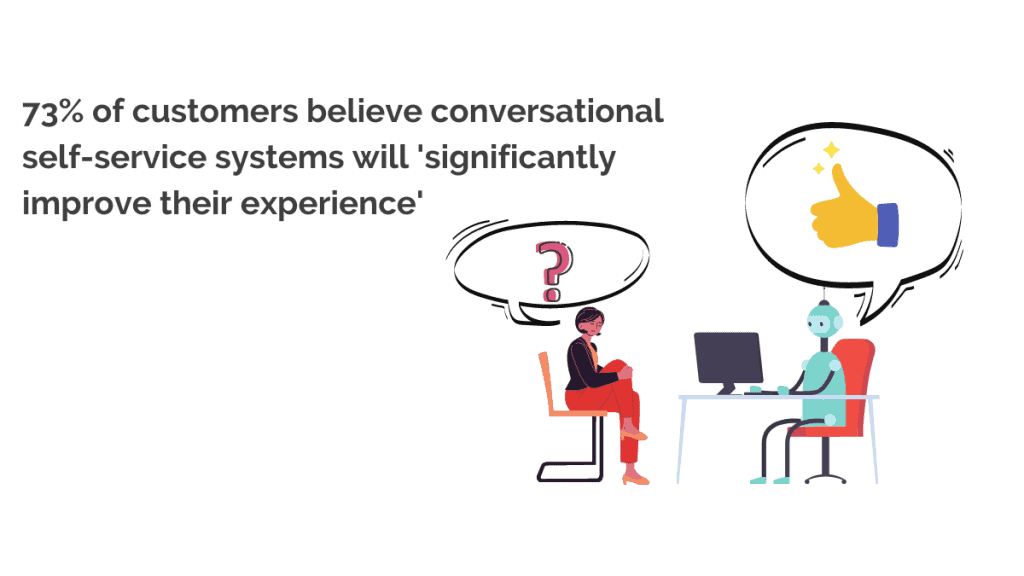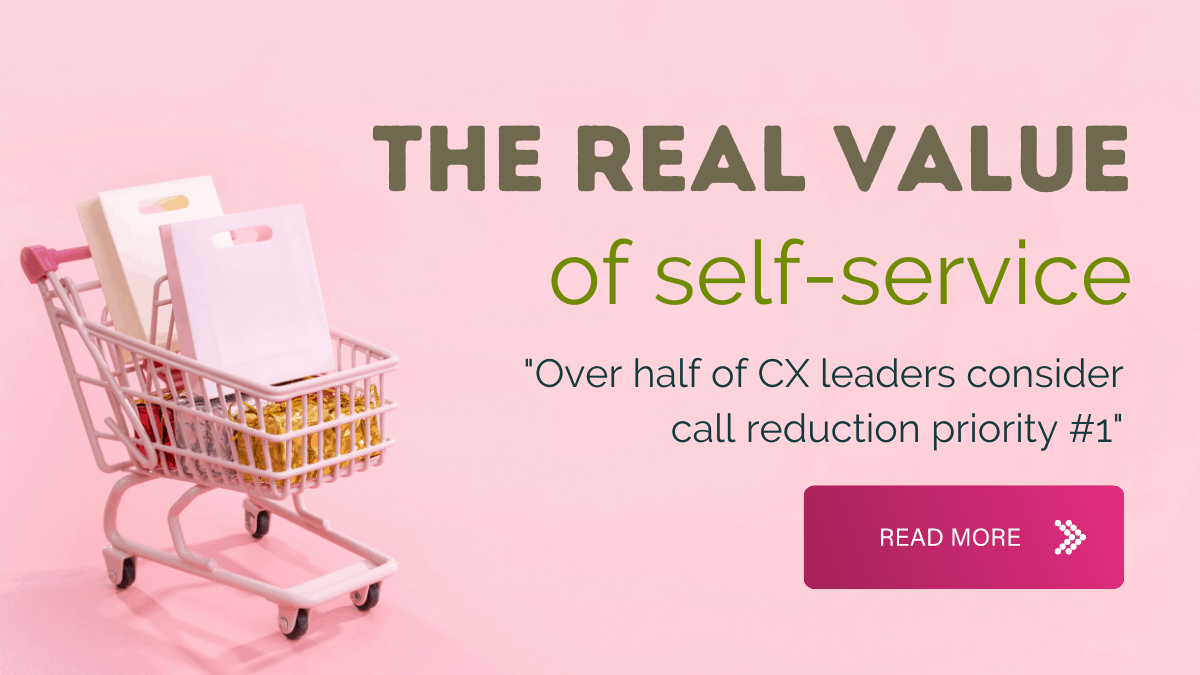Picture the scene.
I’m standing in a (pre-lockdown) queue at a store. Ahead of me, a teenage boy is standing with his mother.
‘It costs me six bucks a month’ he tells her, ‘and I just can’t make it work. I deleted it and downloaded it a second time. Nothing.’
She nods sympathetically.
‘I went through all their FAQs and support videos. It didn’t help.’
She nods again and asks: ‘Did you call their customer support line?’
The boy screws up his face. ‘Call them?’ he says. ‘Like, on the phone?’
And that’s why you need self-service.
***
Ok, that’s not the only reason – but it’s a good place to start. Among millennial consumers, as many as 70% favour self service.
It’s far from limited to younger customers though, and it’s not only consumers driving demand.
In this post:
- The business benefits of self-service options
- Do consumers want self-service options?
- What are the best self-service channels?
- What makes a successful self-service strategy?
- Get started with your (free) automation ebook
The business benefits of self-service options
You’re reading this, so you’ve probably got some key benefits in mind.
But self-service can do a lot for you – possibly more than you think…
#1 Improved customer experience
The age of the customer – it’s still going on. And there’s no end in sight!
Improved customer experience is the rising tide that raises all ships; you’ll see the positive benefits in everything from sales volumes to customer retention to NPS.
65% of consumers feel good about themselves when they’re empowered to solve their own problems. And happy customers stay put!
#2 Money in your pocket
You already know this but it bears repeating: (good) self-service is devastatingly affordable compared with agent-handled interactions.
Obviously there’s a lot of variability but let’s look at the extremes. Gartner puts the average cost of an agent-handled interaction at $8.00 compared with 10 cents for website and app-based service.
#3 Massively increased capacity
Also high on most business’s agenda is making sure that growth targets are achievable. Are you going to have 10% more customers in a year? Then you need 10% more customer support capacity.
That can come from a giant round of hiring. If so, good luck – under one third of contact centers have optimized their ability to source agents with relevant experience.
Clearly, an increase in self-service is the preferred option.
#4 Better agent experience
Ah-ha – maybe you didn’t think of this one?
Here’s how it works. The bulk of interactions that go through self-service are the simple ones like requests for information and password resets.
For agents, this is boring work. It’s repetitive, it usually involves a lot of data entry and it may explain the terrible retention rate for agents. (Typically around 25%.)
Do customers want self-service options?
Yes. Next question?
Ok, more detail. Almost three quarters of customers expect to have the ability to solve a product or service issue on their own.
In the majority of cases that starts with web search.
Here’s why that is important.
Businesses (and contact centers) think about interactions. They think: “When Mrs X has a problem she’s going to pick up the phone – how can we get her to self-serve instead?’
That is totally backwards thinking. When Mrs X has a problem she doesn’t pick up the phone. She Googles it. (Because it’s not 1992.)
She’s only going to pick up the phone if she can’t get a straight answer somewhere else.
Think like your customers!
Mrs X doesn’t think about interactions. She thinks about the problem and the resolution. The possible phone call is one just one part of.
Probably an unwelcome part.
So – you can’t think of self-service as a lot of new channels.
Instead, think about all the possible interventions in your customer’s journey towards resolution.
What are the best self-service channels?
Here’s the short answer: the best self-service channels are the ones you can manage and that customers really want.
How a new channel fit into your existing support processes? If you plant a new self-service option and stand back, you’ll create more problems than you solve.
You also need to make sure that your channels fit your customers.
If you have a pensioner-aged audience, SnapChat is probably not the resource for you.
Still – here are the channels with great ROI for most businesses.

IVR and Conversational AI
Widely used conversational tools mean customers who are more willing to use conversational AI. Think ‘Alexa for your business’.
Good implementations of conversational AI can handle a lot of different and complex tasks. Several major airlines use it to give callers flight information, preempting the need for an agent.
It’s also a useful pre-agent voice channel that gathers information.
That helps out the agent and slashes AHT.
Chatbots
Chatbots are a no-brainer for most organizations. It’s clear that customers visit business websites before calling, making the chatbot the best-placed support tool.
Gartner has repeatedly revised its predictions for chatbot implementation upwards. Most recently they’ve projected a 100% increase in adoption.

SMS (text messaging)
Yep, SMS is still a thing. Unlike new kids on the block like WhatsApp and Messenger, SMS comes pre-built with every cell phone – even the remaining non-smart ones.
SMS messaging also comes with a high level of trust, and enviable read/response rates. Curiously, 41% of millennials say they would be ‘truly satisfied’ if they could use SMS to connect with companies.
FAQs and knowledge bases
A knowledge base takes time to create. But once they’re up and running they’re easily one of the cheapest options.
If you’re looking for a way to reduce investment, couple an FAQ project with a chatbot project. Both involve aggregating common solutions so there’s a healthy degree of overlap.
In fact, they make each other more useful. The most important thing you’ll need to produce is diverse multimedia content like videos and screenshots.
What makes a successful self-service strategy?
There’s no point bringing in new channels without a clear plan. Let’s take a look at how good implementations work.
Focus on customer outcomes, not channels
The objective of your self-service project is to help customers find good outcomes.
You don’t need to focus on cost-reduction. They’ll find you – it’s as close to a sure thing as you’ll ever get!
Make successful resolutions your top priority and let that guide your approach.
Treat self-service like a product
This is a sterling piece of advice from Gartner. Given the work that goes into implementation, businesses tend to think of self-service provision like IT projects. They focus on infrastructure and maintenance.
But it’s not enough that the engine runs – the wheels have to turn as well.
What that means is, do your self-service channels actually produce results? You need to track key customer satisfaction metrics like intent capture, AHT and customer experience.
Use ‘customer ready’ language
This is a small but vital factor.
Many businesses fail to ‘translate’ their internal jargon into something customer understand. The result is like a foreign language as far as customers are concerned.
You probably think that you’re already good at this… but maybe you can be better.
Here’s a common confusion I hear about a lot. Businesses talk about a CRN, meaning Customer Reference Number.
Simple? Customer will figure it out, right.
Sure, mostly. But if you can spell it out, spell it out.
Integrate self-service systems with agent support
You don’t want self-service to become another silo. For one thing, it bugs the hell out of customers – well over half have hung up in frustration because they couldn’t reach an agent.
For another, it’s not the outcome-focused thinking we’re talking about.
Part of the value of well-integrated self-service is that it will make live interactions shorter and smoother.
A customer may travel through your IVR system but still land with an agent. That’s really not a problem – provided the data they’ve supplied travels with them.
In fact, Gartner found that only 9% of customers report solving their issue with self-service alone.
That doesn’t mean you can’t aim higher – we’ve seen much better figures than that – but it does hint at something important about self-service.
It doesn’t need to replace entire interactions to be valuable. In reality, it’s a supplement to normal service that handles tedious, repetitive and error-prone work on behalf of humans





